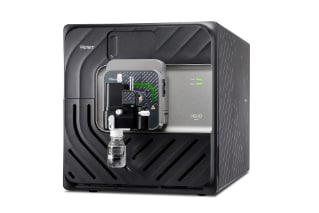Xevo CDMS
See what no one has seen before
Understanding the mass and heterogeneity of large and complex biomolecules has long been a barrier to advancement. Conventional techniques fail to resolve the information needed to reconstruct the detailed nuance of structure, especially for megadalton molecular assemblies. It can take months or even years of tedious, expensive research to understand the basics of biomolecular structures.
Not anymore. With the breakthrough Xevo CDMS instrument, you can achieve precise measurement of challenging large and highly heterogeneous molecules—including viral vectors, virus-like particles (VLPs), RNA, and protein complexes—that were previously out of reach for mass characterization.
With this incredible innovation in charge detection mass spectrometry (CDMS), your lab can answer questions that were previously unaskable, unlocking the future of biological science, drug development, cell and gene therapy, and precision medicine.
Specifications
|
Technology |
Charge detection mass spectrometry with single-ion detection |
|
Detection |
Direct mass measurement powered by ELIT technology |
|
Mass Range |
100 MDa and beyond with molecular weight characterization and purity determination of the largest, most heterogenous biotherapeutics |
|
Resolution |
High-resolution MS analysis of complex mixtures |
|
Sample Types |
Ideal for a variety of sample types including viral particles, protein assemblies, and exosomes |
|
Instrument Footprint |
Modern benchtop design with revolutionary nanoESI source |
|
User Interface |
Intuitive software with guided workflows |
Overview
- Uncover hidden dimensions in biomolecular analysis across cell and gene therapy, biotherapeutics, biophysical science, and nanoparticle research
- Investigate protein structure, function, and mechanisms of diseases at scale with measurement of massive, heterogeneous molecules that were previously invisible
- Achieve real mass clarity with direct, unambiguous, single-ion mass measurement of highly complex, high-mass molecules
- Gain powerful therapeutic insights with characterization of viral vectors, mRNA, and protein complexes
- Get intuitive, ready to submit data workflows, and GxP-ready architecture
Features Header
Expand biomolecular analysis beyond traditional tools with CDMS
Traditional characterization methods like SEC-MALS, analytical ultracentrifugation, and mass photometry often fall short for today’s biomolecules. They require large sample volumes, extended run times, or lack specificity. Xevo CDMS overcomes these limitations with direct, single-ion mass measurement across an extraordinary range, from below 1 MDa to beyond 100 MDa, using as little as 10 µL of sample. With streamlined workflows, faster results, and practical precision, Xevo CDMS delivers insights that conventional tools cannot match, making it a powerful complement or alternative in advanced biomolecular research.
Xevo CDMS vs. Traditional Methods: A Clear Advantage
|
|
|
|
|
|
|---|---|---|---|---|
|
AUC |
Mass Photometry |
SEC-MALS |
Xevo CDMS |
|
|
Ease of Use |
Ease of Use |
Ease of Use |
Ease of Use |
Ease of Use |
|
Ease of Use |
— |
✓ |
✓ |
✓ Simple interfaces, user focused designs |
|
Low Sample Volume |
Low Sample Volume |
Low Sample Volume |
Low Sample Volume |
Low Sample Volume |
|
Low Sample Volume |
— |
✓ |
✓ |
✓ Only requires 10 µl of sample |
|
Mass Range |
Mass Range |
Mass Range |
Mass Range |
Mass Range |
|
Mass Range |
✓ |
— |
✓ |
✓ >100 MDa, but potentially limitless |
|
Specificity |
Specificity |
Specificity |
Specificity |
Specificity |
|
Specificity |
✓ |
— |
— |
✓ Direct measurement on individual structures, able to resolve AAV empty/partial/full/overfull |
|
Compliant Workflows |
Compliant Workflows |
Compliant Workflows |
Compliant Workflows |
Compliant Workflows |
|
Compliant Workflows |
— |
✓ |
✓ |
✓ Support for compliant workflows |
✓ = Problem Solved
AUC: Analytical Ultracentrifugation; SEC-MALS: Size Exclusion Chromatography-Multi-Angle Light Scattering; CDMS: Charge Detection Mass Spectrometry
Differentiate with direct, single-particle mass clarity
At the heart of Xevo CDMS is the Electrostatic Linear Ion Trap (ELIT), a breakthrough technology that isolates and measures individual ions. By capturing both m/z and charge simultaneously, ELIT calculates the true molecular mass of intact biomolecules with unmatched accuracy. Unlike conventional mass spectrometry, which relies on fragmentation or inference, ELIT preserves macromolecular integrity and provides unambiguous single-particle results. It also determines the exact number of charges for each ion, eliminating the need for assumptions or manual assignments. The outcome is mass clarity for highly complex and heterogeneous assemblies, giving researchers confidence in data that is exact, not assumed.
A partner for your future
Xevo CDMS is more than groundbreaking technology. It comes with the assurance of Waters global expertise and customer-first approach. With decades of leadership in separations, mass spectrometry, precision chemistries, and bioprocessing, Waters provides innovation trusted by more than 150,000 installed instruments worldwide. Dedicated service teams deliver industry-leading support and compliance-ready solutions, helping your lab advance biologics development with confidence. Tailored workflows and ongoing scientific collaboration ensure your investment grows with your needs, making Waters a long-term partner in accelerating therapies and achieving discovery goals.
What the experts are saying…
"We’re realizing we can ask entirely new questions with this technique—things we didn’t even think were testable before."
Tim Fenn, VP, Analytical Development and Quality, LEXEO Therapeutics
"A high-resolution tool like CDMS helps ensure your screening is on equal footing. That means better confidence in the pipeline you move forward with."
Ben Draper, Co-Founder and Research Scientist, Megadalton Solutions
"CDMS is going to become essential for analyzing very complex mixtures of proteins."
Professor Martin Jarrold, Department of Chemistry, Indiana University
